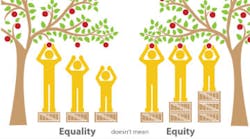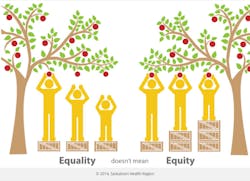Equality and equity in dental treatment aren't exactly the same thing, explains this author. Here's why dental outreach programs should be guided by data in deciding who to serve.
Equity: justice according to natural law or right; specifically: freedom from bias or favoritism.—Merriam-Webster Dictionary
As oral health-care providers in public health, it is our duty to ensure efforts for equity are carried through to the population. Freedom from bias or favoritism may seem easy enough, but these can manifest in many different ways. Are we treating patients out of convenience, profitability, or proximity? Sometimes.
Equality is different from equity. The picture below addresses it well. Equality ensures everyone gets the same resources; in the picture that would be one box to stand on. Equity takes deficits and disparities into account. Equity gives the community the resources they need to succeed; in this picture, equity considers height of the individuals. The goal is each person reaching the apple, and giving each person the same resources does not allow apples for all.
The communities we serve will have disadvantages different from their “height.” Patients may lack oral health due to age, race, or location. The Center for Health Care Strategies describes health disparities as “the metrics we use to measure progress toward achieving health equity.” In other words, we will know oral health is equitable when the disparity gaps are closed. The CDC lists the following oral health disparities for our nation:
- Overall. Non-Hispanic blacks, Hispanics, and American Indians, and Alaska Natives generally have the poorest oral health of any racial and ethnic groups in the United States.
- Children and Tooth Decay. The greatest racial and ethnic disparity among children aged 2–4 years and aged 6–8 years is seen in Mexican American and black, non-Hispanic children.
- Adults and Untreated Tooth Decay. Blacks, non-Hispanics, and Mexican Americans aged 35–44 years experience untreated tooth decay nearly twice as much as white, non-Hispanics.
- Tooth Decay and Education. Adults aged 35–44 years with less than a high school education experience untreated tooth decay nearly three times that of adults with at least some college education.
- In addition, adults aged 35–44 years with less than a high school education experience destructive periodontal (gum) disease nearly three times that of adults with a least some college education.
- Adults and Oral Cancer. The 5–year survival rate is lower for oral pharyngeal (throat) cancers among black men than whites (36% versus 61%).
- Adults and Periodontitis. 47.2% of U.S. adults have some form of periodontal disease. In adults aged 65 and older, 70.1% have periodontal disease.
- Periodontal Disease is higher in men than women, and greatest among Mexican Americans and Non-Hispanic blacks, and those with less than a high school education.1
If our goal is to get oral health to all, we have to address the disparity gaps. If we begin focusing our resources where the deficits exist, we will make progress.
Creating a data-driven outreach program may mean stepping out of our comfort zones. We have to leave our neighborhood, away from people that look like us or speak our native language. This is what justice looks like. This is how we achieve oral health equity for all. Everyone deserves oral health. No child should have to attempt to learn in pain. No adult deserves to lose teeth because of his or her education level. These issues are completely preventable. As dental public health providers, we have a responsibility to consider the data in our community. Our local outreach programs can reflect state data, while national systems and policies should address larger scale issues. All programs should be focusing on disparate groups and narrowing the gaps. As program developers and participants, we need to stack our efforts underneath the folks that cannot quite reach the apple. To learn more about oral health equity and the importance of data-driven programs, go to the campaign for oral health equity at OralHealthAmerica.org.
Read more
Oral Health Equity for All
A Framework for Advancing Oral Health Equity
Disparities in Oral Health
Reference
1. Disparities in Oral Health. CDC website. https://www.cdc.gov/oralhealth/oral_health_disparities/. Updated February 14, 2017. Accessed May 23, 2017.
Editor's note: This article first appeared in RDH eVillage. Click here to subscribe.








